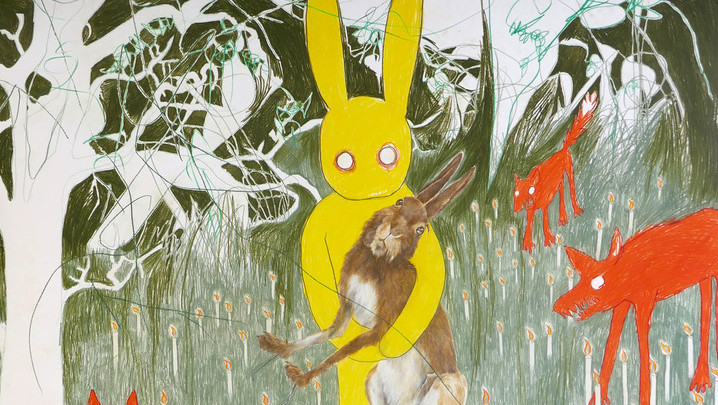Brynhild Winther
True Norwegian Scaredy-Hare
New works by Brynhild Winther

“The oldest and strongest emotion of mankind, is fear, and the oldest and strongest kind of fear is fear of the unknown.” H.P. Lovecraft
You said you wanted to be as free as the birds, and I replied that the birds are not free. Birds must eat worms. They don’t have a choice. Not even birds can fly away from themselves.
When I said that hares and rabbits are metaphors for freedom, you looked at me like you didn’t understand.
I wanted to do an exhibition about the rich symbolism of hares and rabbits and their many metaphorical uses. Descartes used hares in his vivisections … but that was not my reason for wanting to dissect the hare as a metaphor and seeing what else I might find beneath its fur.
No one knows where the hare will jump, and rabbits usually sit around in hutches, but perhaps they are best caught with words.
I was never quite sure why I thought the hare was a metaphor for freedom. Perhaps I got the idea after reading Arto Paasilinna’s The Year of the Hare, or perhaps because hares were the animals I usually saw when jogging in the woods, or it was hares that sprang to mind when reading Sartre’s thoughts on how man is compelled to be free.
In Norway we speak not of the scaredy-cat but of the scaredy-hare. In this exhibition, my point of departure is the scaredy-hare and the hare as a link between us and the underworld. I’m still unsure whether there is a logical connection between these two aspects of the hare, other than the one suggested by Lovecraft in the quote at the top of this text. For me, it is important that I do not know in advance what the process of drawing will reveal. If I knew everything in advance, drawing would have no purpose.
I think aloud with my hands, and do not work from a fixed plan. When you make a point of getting lost, you never know what you will discover along the way. This is why I make notes during the drawing process.
But you don’t get to see all my words, and some of the aspects of the drawing are not captured in words, because drawing follows a logic that is not constrained by the rules of grammar.
One day I met a strange hare. I promised Hare that he could come along with me on my journey. He would be present with a photo project of his own. He had recently discovered the way humans use nature as a backdrop for their recreation and as a visual basis for the digital alter egos they construct for themselves. That made him angry. Or frustrated. I’m not sure which.
Either way, he found it highly provocative that hares and rabbits should be seen as metaphors, and not as individuals, like other people. Hare has a fetish for photography that shows “faults” such as arbitrary composition and blurred focus. I ask what it implies for authenticity if he deliberately constructs “faults” to make things seem more real. And if it simply gives the impression that he doesn’t know what he’s doing.
Hare responds by criticising the way I use animals as metaphors, a response that marks the beginning of his struggle to ensure animals who lack human traits and animals who are not cute are also valued as individuals. One day he said to me that the hare in the forest is not just a reiteration of the idiot who posed for the photograph alongside the description of his species in my animal identification book.
He added that one day he would write a book with a similarly simplistic and banal description of the human species. Because humans do not understand the world through language, but use words to make it comprehensible. Consequently, the only thing humans know is the nonsense they themselves have invented based on their own strange logic. Now he’s down in his den, pinning up demonstration posters.
He has also set fire to mushrooms in the forest, which I think has something to do with his personal dislike for Alice in Wonderland. Or perhaps it’s a kind of ritual. I don’t know.
That was the moment the fox appeared …
The exhibition at Møre og Romsdal Kunstsenter is one of five exhibitions in which Hare and I explore different aspects of the relationship between hares and other people. Three of the other exhibitions will feature other drawings that adopt different perspectives from those seen here. They will be shown at Bærum Kunsthall 2020, Visningsrommet USF Verftet 2020, and Galleri Christinegaard in 2021. The final exhibition in this project will present a kind of summary of what the hare and I have found out. This will be shown at Haugesund Kunstforening at the end of 2021.
Brynhild Winthers text is translated from Norwegian by Peter Cripps / The Wordwrights 2020
The exhibition is produced with funding from Bildende Kunstneres Vederlagsfond and Arts Council Norway. MRK is supported by Møre and Romsdal County council.
ARTISTBOOK
As part of Jugenstilsenteret & KUBE’s project RESTRIKSJONSKUNST, Brynhild Winther has also made an artist book.The book is printed in one edition of 350 copies and during the month of November this artist book will be sent out to interested parties by post.
To secure a copy, send your name and postal address to: restriksjonskunst@mupsu.no